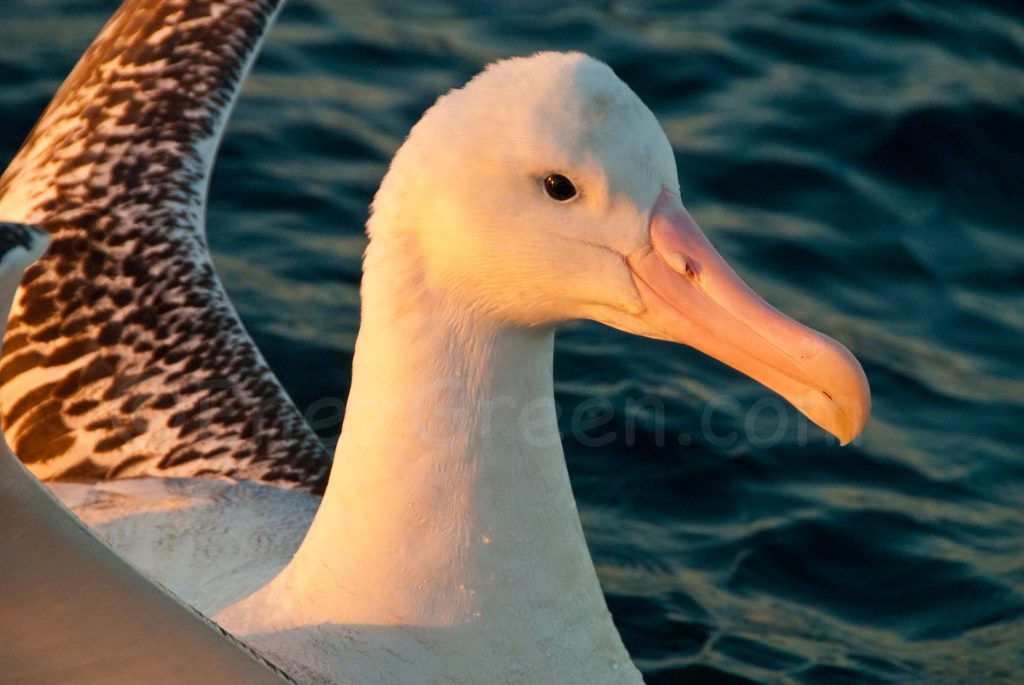A bird that ceaselessly flies over the oceans almost without flapping its wings
Gary points to a big albatross barely a metre away from us. ‘It is a large female wandering albatross; it can be identified thanks to its bright red beak and legs,’ explains the captain, who knows so well his daily friends that he managed one day to catch a female with a broken leg to treat it! After having taken a look at the imposing beak of albatrosses, we have an even greater respect for Gary. With over 25 years of deep-sea fishing experience in the southern seas and almost 14 years with pelagic birds, our captain has developed a unique understanding of these animals and has managed with time to identify certain individuals. ‘Most of the albatrosses sighted in Kaikoura have travelled thousands of kilometres from their egg-laying site to this site offering plenty of food supply. The wandering albatross can ceaselessly fly day and night over the southern ocean.’ A major characteristic of the albatross is its ability to fly over long distances without flapping its wings.
The ‘long haul’ secret flights of albatross
What is its secret? Gary explains that it uses two rapid and energy saving flying techniques which allow it to travel kilometres without constantly feeling the need to eat. All seabirds use the ‘slope soaring’ technique, which consists in flying through the crests of waves in order to use the deflection of the wind. But albatrosses use mostly the ‘dynamic soaring’ technique, thus gaining energy by repeatedly crossing the boundary between air masses of different velocities. They are thus able to glide dynamically by diving into the troughs of waves and wheeling back above the crests of the waves.
The dual behaviour of the albatross, so majestic at sea and so awkward on land
We seize this unique opportunity to admire various albatross species gliding in the air and following the progress of our boat. However, while their majestic flights inspire respect, the landings and take-offs of these birds are rather funny. Their short legs with broad webbed feet allow them to swim efficiently, but give them an awkward gait, especially when taking off. Due to their massive wingspan, they must run over tens of metres in order to take off. This reminds us of the verses of the French poet, Baudelaire, about the dual behaviour of the albatross:
‘The winged visitor, so awkward and weak!
So recently beautiful, now comic and ugly!’
Baudelaire, the accursed French poet, compared the place of poets in society to that of the albatross: majestic in its element, the sky, but awkward on land. Similarly, poets and their poems are above the crowd of ordinary mortals, but are often mocked by the crowd.
Approximately 100,000 albatrosses are killed each year
It was while he was travelling to Reunion Island, at the age of 20, that the poet learnt about traditional albatross fishing perpetuated by seamen of the time, who considered the albatross a bird of ill omen, reminding them of the men that were rarely rescued after falling into the sea and who were attacked by albatrosses. The triangle-shaped fishing device – a fishing line with a float made of cork and an iron triangle to which is tied a piece of meat – was in fact the emblem of the Association of International Association of Cape Horners. These birds were also hunted for their feathers and sometimes for their flesh.
One and a half-century later, this trade has stopped and the triangle-shaped fishing device is no longer used, but a far more dangerous type of fishing is threatening with extinction many albatross species: longline fishing, which consists in lines spreading out over dozens of kilometres and containing several baited hooks in which the birds get caught and end up drowning. BirdLife International estimates that over 100,000 are killed each year due to longline fishing. In the end, 18 out of the 22 albatross species on the planet are currently threatened!
After two hours of intense bird observation under the reddish-pink lights and bronze tints of sunrise, we return to the port, exhausted by this rich and fascinating encounter. We realise how fortunate we are to have had the opportunity of admiring no fewer than seven albatross species in two and a half hours just ten minutes from the port with a Cape Horner turned naturalist guide. Garry, that we now familiarly call by his nickname, ‘Gazza’, provides us with an overview of the species observed. It is worth noting that five out of the six great albatross species can be observed in Kaikoura, including three species of wandering albatross (Diomedea exulans, gibsoni, antipodensis) as well as the northern and southern royal albatrosses.
Kaikoura a unique place in the world for the observation of animals
Out of the four existing genera of albatross, we have mainly sighted various species of the two main ones, i.e. the family of large Diomedea albatrosses and the smaller Southern Hemisphere Thalassarche family. Individuals of this latter genus are easily identified as they are incredibly photogenic and have ‘Robocop’ looks, as we nicknamed them (!). Among the great albatrosses, wandering albatrosses and royal albatrosses visited us together with other individuals from the Bullers, South Atlantic, white-capped, black-browed as well as Salvin’s species.
There are also other seabird species such as the imposing Southern giant petrels, black petrels, white-chinned petrels, shy Buller’s shearwaters, Hutton’s shearwaters that are endemic to the region, beautiful Cape petrels as well as red and black-billed gulls.
If there is a place on Earth where such amazing encounters with sea animals occur so frequently, its name is undoubtedly… Kaikoura!




